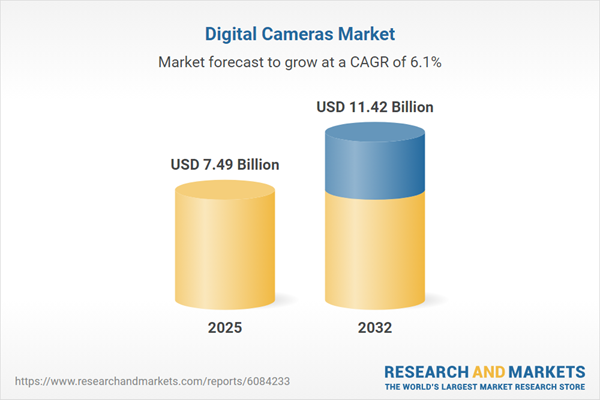Speak directly to the analyst to clarify any post sales queries you may have.
The global digital cameras market is experiencing a period of rapid evolution shaped by technological innovation, new content creation demands, and dynamic shifts in consumer and professional applications.
Market Snapshot: Digital Cameras Market Size and Growth
The Digital Cameras Market grew from USD 7.08 billion in 2024 to USD 7.49 billion in 2025. It is expected to advance at a CAGR of 6.14%, reaching USD 11.42 billion by 2032. This trajectory reflects increasing adoption of advanced imaging technologies, robust consumer and professional demand, and continued innovation from both legacy manufacturers and new entrants in the digital camera sector.
Scope & Segmentation of the Digital Cameras Market
This research provides an in-depth analysis across multiple dimensions vital for strategic planning:
- Product Type: Bridge compact digital cameras, compact digital cameras, digital rangefinders, digital single-lens reflex (DSLR) cameras, electronic viewfinder models, and mirrorless interchangeable lens cameras.
- Component: Batteries, LCD screens, lenses, memory cards, and sensors, each impacting performance and differentiation.
- Lens Type: Built-in and interchangeable lens options addressing user preferences from simplicity to creative flexibility.
- Resolution: High resolution and low to medium resolution categories meeting the spectrum of user demands from professional quality to rapid, social-ready content delivery.
- End-User: Amateur photographers—including hobbyists and influencers—and professional cohorts, such as sports and wedding photographers, each with distinct workflows and feature priorities.
- Distribution Channel: Offline retail and online platforms, catering to varying buyer behaviors and service expectations.
- Geography: Americas; Europe, Middle East & Africa; and Asia-Pacific, encompassing markets from North America and Western Europe to dynamic APAC economies and emerging African regions.
The report also covers leading organizations influencing the market landscape, such as Canon Inc., Sony Electronics Inc., SAMSUNG Electronics Co., Ltd., FUJIFILM Corporation, Nikon Corporation, Panasonic Holdings Corporation, and Blackmagic Design Pty. Ltd., among others.
Key Takeaways: Strategic Insights for Senior Decision-Makers
- Mirrorless camera adoption is steadily displacing traditional DSLR platforms, prompting manufacturers to prioritize modularity and user customization.
- Integration of Wi-Fi, Bluetooth, and cloud-enabled workflows elevates both ecosystem connectivity and productivity across professional and enthusiast segments.
- Content creator growth is fueling demand for hybrid photo-video cameras capable of advanced stabilization and real-time editing features.
- Regulatory shifts, including new US tariffs, are prompting supply chain diversification and increased automation in manufacturing and assembly strategies.
- Sustainability considerations are influencing both material sourcing and after-sales lifecycle initiatives, impacting brand positioning in environmentally conscious segments.
- Region-specific strategies remain essential, as local consumer preferences, trade policies, and manufacturing ecosystems differ widely across global markets.
Tariff Impact: Navigating Regulatory and Economic Headwinds
New tariffs slated for the United States in 2025 are driving a reassessment of cross-border production, encouraging relocation of assembly facilities to Southeast Asia and Latin America. Firms are also investing in robotics and digital manufacturing solutions to offset increased costs, while exploring partnerships with local suppliers to reinforce supply chain resilience in a regulatory-driven environment.
Methodology & Data Sources
This report leverages a comprehensive research methodology, combining in-depth interviews with industry stakeholders, an extensive review of technical and regulatory sources, and advanced data modeling. Findings are peer-reviewed by domain analysts and technology experts to ensure accuracy and actionable insights for strategic planning.
Why This Report Matters
- Enables strategic alignment with emerging technological, regulatory, and consumer trends in the digital cameras market.
- Delivers granular competitive benchmarking and actionable recommendations to maintain or improve market positioning.
- Supports investment, innovation, and supply chain decisions tailored to evolving industry complexities.
Conclusion
Senior decision-makers seeking to unlock growth in the digital cameras sector will benefit from this report’s comprehensive analysis of evolving market drivers, segmentation dynamics, and actionable pathways for innovation and competitiveness. Navigate industry change with strategic clarity and data-driven foresight.
Table of Contents
3. Executive Summary
4. Market Overview
7. Cumulative Impact of Artificial Intelligence 2025
Companies Mentioned
The companies profiled in this Digital Cameras market report include:- Advantech Co., Ltd.
- BHH, LLC
- Blackmagic Design Pty. Ltd.
- Canon Inc.
- Carl Zeiss AG
- CASIO COMPUTER CO., LTD.
- Diamond Technologies.
- Eastman Kodak Company
- FUJIFILM Corporation
- HP Development Company, L.P.
- JMM Lee Properties, LLC
- Kyocera Corporation
- Leica Camera AG
- Nikon Corporation
- Olympus Corporation
- Panasonic Holdings Corporation
- Phase One A/S
- Ricoh Company, Ltd.
- Sakar International, Inc.
- SAMSUNG Electronics Co., Ltd.
- Seiko Epson Corporation
- Sigma International Group, Inc.
- Sony Electronics Inc.
- Toshiba Teli Corporation
- Victor Hasselblad AB
Table Information
| Report Attribute | Details |
|---|---|
| No. of Pages | 199 |
| Published | November 2025 |
| Forecast Period | 2025 - 2032 |
| Estimated Market Value ( USD | $ 7.49 Billion |
| Forecasted Market Value ( USD | $ 11.42 Billion |
| Compound Annual Growth Rate | 6.1% |
| Regions Covered | Global |
| No. of Companies Mentioned | 26 |









